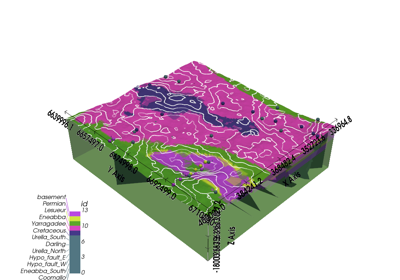gempy.core.data.Grid¶
- class gempy.core.data.Grid(**kwargs)[source]¶
Class to generate grids.
This class is used to create points to evaluate the geological model. This class serves a container which transmits the XYZ coordinates to the interpolator. There are several type of grid objects feeding into the Grid class
- Parameters:
**kwargs – See below
- Keyword Arguments:
regular (
gempy.core.grid_modules.grid_types.RegularGrid) – [s0]custom (
gempy.core.grid_modules.grid_types.CustomGrid) – [s1]topography (
gempy.core.grid_modules.grid_types.Topography) – [s2]sections (
gempy.core.grid_modules.grid_types.Sections) – [s3]gravity (
gempy.core.grid_modules.grid_types.Gravity) –
- values¶
coordinates where the model is going to be evaluated. This is the coordinates concatenation of all active grids.
- Type:
np.ndarray
- values_r¶
rescaled coordinates where the model is going to be evaluated
- Type:
np.ndarray
- length¶
I a array which contain the slicing index for each grid type in order. The first element will be 0, the second the length of the regular grid; the third custom and so on. This can be used to slice the solutions correspondent to each of the grids
- Type:
np.ndarray
- grid_types¶
names of the current grids of GemPy
- Type:
np.ndarray[str]
- active_grids_bool¶
boolean array which controls which type of grid is going to be computed and hence on the property values.
- Type:
np.ndarray[bool]
- regular_grid¶
- Type:
gempy.core.grid_modules.grid_types.RegularGrid
- custom_grid¶
- Type:
gempy.core.grid_modules.grid_types.CustomGrid
- topography¶
- Type:
gempy.core.grid_modules.grid_types.Topography
- sections¶
- Type:
gempy.core.grid_modules.grid_types.Sections
- gravity_grid¶
- Type:
gempy.core.grid_modules.grid_types.Gravity
Examples using
gempy.core.data.Grid¶Methods
__init__(**kwargs)create_centered_grid(centers, radius[, ...])Initialize gravity grid.
create_custom_grid_(custom_grid)Set a new regular grid and activate it.
create_regular_grid([extent, resolution, ...])Set a new regular grid and activate it.
create_section_grid(section_dict)create_topography_([source])Create a topography grid and activate it.
Deactivates the active grids array :return:
get_grid(grid_name)get_grid_args(grid_name)get_section_args(section_name)set_active(grid_name)Set active a given or several grids :param grid_name: :type grid_name: str, list
set_inactive(grid_name)Copy XYZ coordinates from each specific grid to Grid.values for those which are active.
Attributes
active_grids- create_regular_grid(extent=None, resolution=None, set_active=True, *args, **kwargs)[source]¶
Set a new regular grid and activate it.
- Parameters:
extent (np.ndarray) – [x_min, x_max, y_min, y_max, z_min, z_max]
resolution (np.ndarray) – [nx, ny, nz]
RegularGrid Docs
- create_custom_grid_(custom_grid: ndarray)[source]¶
Set a new regular grid and activate it.
- Parameters:
custom_grid (np.array) – [s0]
- create_topography_(source='random', **kwargs)[source]¶
Create a topography grid and activate it.
- Parameters:
source –
‘gdal’: Load topography from a raster file.
’random’: Generate random topography (based on a fractal grid).
’saved’: Load topography that was saved with the topography.save() function. This is useful after loading and saving a heavy raster file with gdal once or after saving a random topography with the save() function. This .npy file can then be set as topography.
- Keyword Arguments:
'gdal' (source =) –
filepath: path to raster file, e.g. ‘.tif’, (for all file formats see https://gdal.org/drivers/raster/index.html)
'random' (source =) –
fd: fractal dimension, defaults to 2.0
d_z: maximum height difference. If none, last 20% of the model in z direction
extent: extent in xy direction. If none, geo_model.grid.extent
resolution: desired resolution of the topography array. If none, geo_model.grid.resoution
'saved' (source =) –
filepath: path to the .npy file that was created using the topography.save() function
- Returns:
class:gempy.core.data.Topography
- create_centered_grid(centers, radius, resolution=None)[source]¶
Initialize gravity grid. Deactivate the rest of the grids


